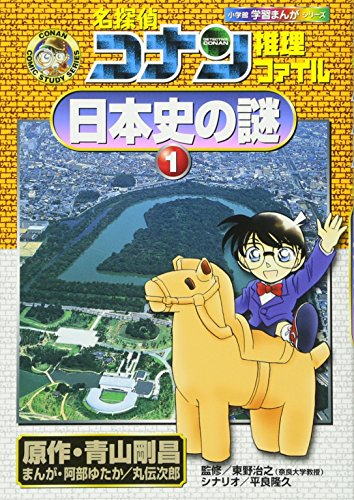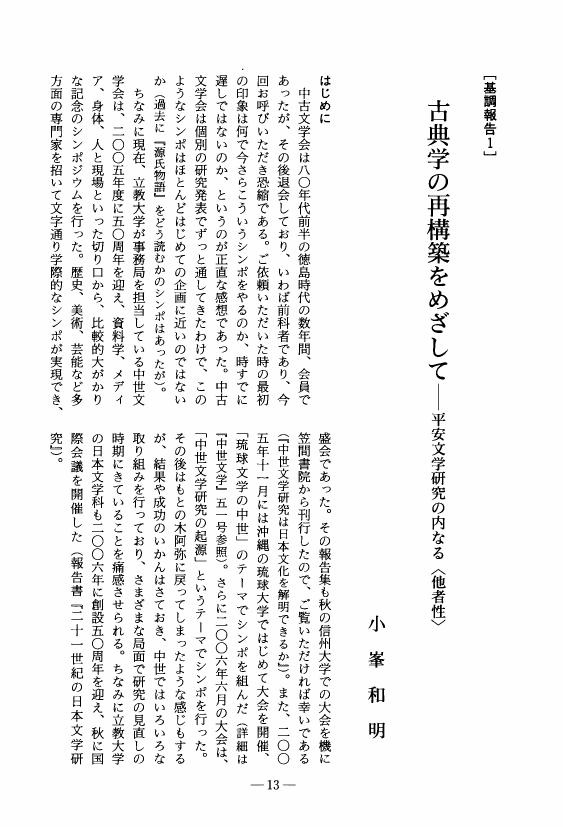17 0 0 0 日記にみる藤原頼長の男色関係--王朝貴族のウィタ・セクスアリス
- 著者
- 東野 治之
- 出版者
- 大阪歴史学会
- 雑誌
- ヒストリア (ISSN:04392787)
- 巻号頁・発行日
- no.84, pp.p15-29, 1979-09
9 0 0 0 OA 聖徳太子の人物像と千三百年御忌
- 著者
- 東野 治之
- 出版者
- 日本学士院
- 雑誌
- 日本學士院紀要 (ISSN:03880036)
- 巻号頁・発行日
- vol.77, no.1, pp.1-16, 2022 (Released:2022-12-12)
Rare is such a historical figure who has been the subject of review for so many generations as Prince Shōtoku (574–622). His image alone serves as an entire research topic. This paper focuses on Prince Shōtoku Hōsankai, an honoring party founded in 1921, and examines how it impacted the modern view of Prince Shōtoku. In general, Prince Shōtoku is known as the regent and prince to Empress Suiko, suppressing tyranny of the Gōzoku (prominent clans) and striving for a central government led by the emperor. Prince Shōtoku established diplomatic relations with the Sui dynasty and promoted the civilization of Japan by proactively adopting the Chinese culture. This perception was based on the Nihon Shoki (The Chronicles of Japan, written in 720). However, modern research has denied the existence of a prince or regent during the Suiko dynasty. Additionally, Prince Shōtoku was most likely an advisor to Empress Suiko and Soga no Umako, without much involvement in government policies. (View PDF for the rest of the abstract.)
1 0 0 0 OA 大嘗会の作り物 : 標の山の起源と性格
- 著者
- 東野 治之
- 出版者
- 国立歴史民俗博物館
- 雑誌
- 国立歴史民俗博物館研究報告 = Bulletin of the National Museum of Japanese History (ISSN:02867400)
- 巻号頁・発行日
- vol.114, pp.21-32, 2004-02-27
大嘗会の際に設けられる標の山は、日本の作り物の起源に関わるものとされ、主として民俗学の分野からその意義が注目されてきた。しかしその歴史や実態については、いまだ未解明の点も多い。本稿では、まず平安初期の標の山が中国風の装飾を凝らした大規模なものであったことを確認した上で、『万葉集』に見られる八世紀半ばの歌群から、新嘗会の標の山が、同様な中国風の作り物であったことを指摘する。大嘗会は本来新嘗会と同一の祭りであり、七世紀末に分離されて独自の意味をもつようになったとされるが、そうした経緯からすれば、この種の作り物が、当初から中国的な色彩の濃いものであったことも容易に推定できる。そのことを傍証するのが、和銅元年(七〇八)の大嘗会の状況であって、それを伝えた『続日本紀』の天平八年(七三六)の記事は、作り物の橘が金銀珠玉の装飾とともに用いられていたことを示している。従って、大嘗会の標の山は、大嘗会の成立に近い時点で中国的な性格を持っていたわけで、その特色はおそらく大嘗会の成立時点にまで遡るであろう。このように見ると、標の山は神の依り代として設けられたもので、本来簡素な和風のものであったが、次第に装飾が増え中国化したとする通説には大きな疑問が生じる。そこで改めて標の山の性格を考えると、その起源は、すでに江戸時代以前から一部で言われてきたように、儀式進行上の必要から設けられた標識にあり、それが独自の発展を遂げたものと解すべきである。なお、大嘗会の標の山について、その形態をうかがわせる史料は限られているが、元慶六年(八八二)の相撲節会に用意された標の山に関しては、菅原道真が作った文から詳細が判明し、大きさや装飾が大嘗会のものと類似していたことがわかる。この文についての従来の読みには不十分な点があるので、改めて訓読を掲げ参考とした。
1 0 0 0 美努岡万墓誌の述作--「古文孝経」と「論語」の利用をめぐって
- 著者
- 東野 治之
- 出版者
- 万葉学会
- 雑誌
- 万葉 (ISSN:03873188)
- 巻号頁・発行日
- no.99, pp.p59-70, 1978-12
- 著者
- 西山 要一 植田 直見 桐野 文良 野尻 忠 早川 泰弘 今津 節生 東野 治之 関根 俊一 望月 規史 成瀬 正和
- 出版者
- 奈良大学
- 雑誌
- 基盤研究(A)
- 巻号頁・発行日
- 2018-04-01
携帯型蛍光X線分析装置、据付型蛍光X線分析装置、X線回折装置、X線透過撮影装置など多種の分析器機・調査機器を活用して真鍮製考古資料・美術工芸品の成分分析等を行った。三重・大宝院所蔵大般若経八巻(紺紙金字経)の詳細な科学分析、および平安~江戸時代の紺紙金字経・同断簡の分析などによって、経典写経における真鍮泥使用の広がりを把握し、その宗教的・技術的・経済的な意味を歴史上に位置付けることを試みた。また古代~中世の京都・平安京跡、岩手・平泉遺跡、近世の奈良・奈良町遺跡、和歌山城跡などの出土銅合金・真鍮資料・鋳造資料を悉皆的に科学分析し、各遺跡・各時代における真鍮製品の実態を把握した。美術工芸資料調査では、長谷寺・九鈷鈴(中国・元時代)、當麻寺・螺鈿玳瑁螺鈿唐草合子(朝鮮・高麗時代)の将来品の分析を行い真鍮が使われていることを確認した。この種の日本製真鍮製品が見当たらないことから、真鍮の利用に日本と両国の間では様相を異にすると考えられる。近世には日本絵画の彩色に真鍮泥が使われる諸例を明らかにしつつあり、江戸時代以降の広範な真鍮利用の実態が判明しつつある。史料学調査では、日本・韓国の真鍮関連の古記録の探索の中で、新たに朝鮮の「三国史記」に真鍮関連の記載を見いだし、その真鍮史上の位置付けを試みている。さらに、韓国の真鍮資料を同国の分析科学者の協力を得て科学分析データおよび記録データの収集を行った。紀元前より真鍮製品(ローマコインなど)が存在するヨーロッパの諸例のデータも研究協力者の助力を得て収集し、日本の真鍮製品との共通性と差異、西アジアに発するとされる真鍮の起源とその伝来の道(ブラスロード)と歴史の一端を垣間見ることができた。これらの研究成果は、昨年度報告と同様に2019年度研究成果(冊子)にまとめ、日本文化財科学会大会(2020年7月)などで公表の予定である。
1 0 0 0 遣唐使に見る日本の対外交流 (坂井秀弥先生退職記念論集)
- 著者
- 東野 治之
- 出版者
- 奈良大学文学部文化財学科
- 雑誌
- 文化財学報 (ISSN:09191518)
- 巻号頁・発行日
- vol.38, pp.11-15, 2020-03
1 0 0 0 OA 〈中古文学〉の将来 研究・学会・社会
1 0 0 0 那須国造碑と律令制(第九八回史学会大会報告記事)
- 著者
- 東野 治之
- 出版者
- 公益財団法人 史学会
- 雑誌
- 史学雑誌 (ISSN:00182478)
- 巻号頁・発行日
- vol.109, no.12, 2000
1 0 0 0 IR 大嘗会の作り物--標の山の起源と性格 (共同研究 「つくり物」の総合的研究)
- 著者
- 東野 治之
- 出版者
- 国立歴史民俗博物館
- 雑誌
- 国立歴史民俗博物館研究報告 (ISSN:02867400)
- 巻号頁・発行日
- vol.114, pp.21-32, 2004-02
大嘗会の際に設けられる標の山は、日本の作り物の起源に関わるものとされ、主として民俗学の分野からその意義が注目されてきた。しかしその歴史や実態については、いまだ未解明の点も多い。本稿では、まず平安初期の標の山が中国風の装飾を凝らした大規模なものであったことを確認した上で、『万葉集』に見られる八世紀半ばの歌群から、新嘗会の標の山が、同様な中国風の作り物であったことを指摘する。大嘗会は本来新嘗会と同一の祭りであり、七世紀末に分離されて独自の意味をもつようになったとされるが、そうした経緯からすれば、この種の作り物が、当初から中国的な色彩の濃いものであったことも容易に推定できる。そのことを傍証するのが、和銅元年(七〇八)の大嘗会の状況であって、それを伝えた『続日本紀』の天平八年(七三六)の記事は、作り物の橘が金銀珠玉の装飾とともに用いられていたことを示している。従って、大嘗会の標の山は、大嘗会の成立に近い時点で中国的な性格を持っていたわけで、その特色はおそらく大嘗会の成立時点にまで遡るであろう。このように見ると、標の山は神の依り代として設けられたもので、本来簡素な和風のものであったが、次第に装飾が増え中国化したとする通説には大きな疑問が生じる。そこで改めて標の山の性格を考えると、その起源は、すでに江戸時代以前から一部で言われてきたように、儀式進行上の必要から設けられた標識にあり、それが独自の発展を遂げたものと解すべきである。なお、大嘗会の標の山について、その形態をうかがわせる史料は限られているが、元慶六年(八八二)の相撲節会に用意された標の山に関しては、菅原道真が作った文から詳細が判明し、大きさや装飾が大嘗会のものと類似していたことがわかる。この文についての従来の読みには不十分な点があるので、改めて訓読を掲げ参考とした。一部非公開情報あり
1 0 0 0 法隆寺献納宝物 皇太子御斎会奏文の基礎的考察
- 著者
- 東野 治之
- 出版者
- 東京国立博物館
- 雑誌
- 東京国立博物館研究誌 (ISSN:00274003)
- 巻号頁・発行日
- no.607, pp.5-17, 2007-04
1 0 0 0 OA 東大寺法華堂天蓋の奈良時代墨書
- 著者
- 東野 治之
- 出版者
- 日本学士院
- 雑誌
- 日本學士院紀要 (ISSN:03880036)
- 巻号頁・発行日
- vol.72, no.3, pp.77, 2018 (Released:2018-05-14)
Hokke-do Hall at Todaiji Temple is widely known as a monument built in the beginning of the 8th century, and it is also famous for the many original Buddist statues that are still there. In 2015, construction work was carried out on the building to reinforce it against earthquakes. During this process, a number of ancient writings written in India ink were discovered, including writings from the original construction. These writings were discovered in the canopy within the hall, under the floorboards, and in the halo of the main statue. These writings contain some things of great historical significance, and yet, due to various circumstances, we have reached the present day without making any official report. At the request of the Agency for Cultural Affairs, I have looked at almost all of these writings, and I have received digital photos of them. This paper examines the results of deciphering a particularly important writing, the writing in India ink found in the canopy, and it describes its significance in cultural history. Below is a summary of this. In order from east to west, the canopies in Hokke-do Hall are called the eastern canopy, the central canopy, and the western canopy. When they were created, they were each different, and looking at them from the perspective of art, the eastern canopy is a work of art from the Nara period (with modern repairs that have been done to it), the central canopy is from the Kamakura period, and the western canopy is from the time of original construction, the Nara period. The most notable of the discovered India-ink writings were those from the western canopy. The era that those writings came from was determined based on the construction situation of the canopy, and they seem to have been written after the materials for the canopy were prepared but before the canopy was completed. Some interesting content from those writings included a phrase written in the style of Chinese poetry in two different places that means “last night I slept with a young unmarried woman, but the night was too short, and my love was not properly exhausted.” This sort of content—not appropriate for a Buddhist temple—written in scribbles or on practice writing paper in the style of Chinese poetry is not necessarily rare. For example, there are five words scribbled on the inside of the pedestal of the Shakyamuni triad in the main Hall of Houryuuji that was created around the year 623. Additionally, there are also some scribbles in the style of Chinese poetry that can be seen on the wooden writing plates from the end of the 7th century that were excavated from Asuka-ike site in Nara Prefecture. Both of these have content that suggests a rendezvous between a man and a woman, and the ideas and format seem consistent with the writings found in the canopy. The characters that partially remain, such as “beautiful,” “a bush warbler sings,” and “pleasant voice,” could also be part of a series, with these phrases written in the style of Chinese poetry. (View PDF for the rest of the abstract.)
1 0 0 0 OA 平城宮木簡
1 0 0 0 IR 東アジアの中の富本銭
- 著者
- 東野 治之
- 出版者
- 奈良大学文学部文化財学科
- 雑誌
- 文化財学報 (ISSN:09191518)
- 巻号頁・発行日
- vol.19, pp.23-41, 2001-03
- 被引用文献数
- 1
本稿は、一九九九年七月二十五日に開かれた市民の古代研究会全国集会における記念講演を文章化したものである。講演内容は、同会の河野宏文氏によってテープ起こしされ、同年十月一日及び十一月一日刊行の『市民の古代ニュース』(一九六、一九七号) の付録として会員に配布されたが、その性格上、一般に周知されたとはいえなかった。それにもかかわらず、富本銭関係の論文に引用して下さる方もある。そこで右の付録の内容に大幅な筆削を加え、公刊することとした。講演であることを尊重して、文体は「です」「ます」調を踏襲し、史料は読み下しとした。論旨に関わるような改変は加えていない。ただ和同銀銭と「前銀」の関係にふれた箇所は、新たに付加えた。また注も、発言の典拠を示すため新たに付けることとした。なお、飛鳥池遺跡出土の富本銭に関する情報は、その後刊行された『奈良国立文化財研究所年報1999Ⅱ』『同上2000Ⅱ』にまとめられている。
1 0 0 0 内外東方學界消息 日本國號の硏究動向と課題
- 著者
- 東野 治之
- 出版者
- 東方学会
- 雑誌
- 東方学 (ISSN:04957199)
- 巻号頁・発行日
- vol.125, pp.140-149, 2013-01
1 0 0 0 百済人祢軍墓誌の「日本」
1 0 0 0 OA 奈良時代の仏教美術と東アジアの文化交流
- 著者
- 湯山 賢一 西山 厚 鈴木 喜博 岩田 茂樹 内藤 栄 稲本 泰生 吉澤 悟 宮崎 幹子 谷口 耕生 野尻 忠 研清水 健 岩戸 晶子 斎木 涼子 北澤 菜月 永井 洋之 中島 博 有賀 祥隆 前園 実知雄 東野 治之 根立 研介 藤岡 穣 高橋 照彦 山崎 隆之 梶谷 亮治 杉本 一樹 成瀬 正和 尾形 充彦 西川 明彦 森實 久美子 原 瑛莉子
- 出版者
- 独立行政法人国立文化財機構奈良国立博物館
- 雑誌
- 基盤研究(A)
- 巻号頁・発行日
- 2008
「奈良朝仏教美術の主要作例、もしくはその国際性を考える上で重要な周辺作例の中から対象とする文化財を選定し、それらに関する基礎資料を学界の共有財産として提供する」という目的に沿って調査研究を行い、22年度末に5部構成・2分冊からなる研究成果報告書を刊行した。薬師寺に伝来した藤田美術館所蔵大般若経(魚養経)全387巻の撮影及び書誌的データの集成、蛍光X線分析による香取神宮所蔵海獣葡萄鏡や東大寺金堂鎮壇具の成分分析を通した制作地の特定などが、代表的な成果である。

